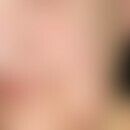Synonym(s)
HistoryThis section has been translated automatically.
DefinitionThis section has been translated automatically.
Benign cysts that originate from the eccrine sweat glands.
A distinction is made between:
- a solitary form with cystic expansion of the secreting sweat glands (Smith type)
- from
- the multiple form with ectasia of the blind ending sweat gland duct (Robinson type).
You might also be interested in
LocalizationThis section has been translated automatically.
Mainly eyelids and cheeks, more rarely also on the trunk and extremities.
ClinicThis section has been translated automatically.
HistologyThis section has been translated automatically.
Dermal located mostly collapsed, secretion-filled epithelial cyst with two-rowed, mostly flattened epithelium. There is no connection to the ceiling epithelium. The decapitation phenomena typical for apocrine secretion are missing. Immunohistologically, expressions of the cytokeratins 8 and 19 are found in the luminal cyst wall; the cytokeratins 5,10,14 are expressed in both the luminal and the outer cell layer of the cyst wall.
Differential diagnosisThis section has been translated automatically.
TherapyThis section has been translated automatically.
If therapy is required for solitary forms of excision or cauterization. Furthermore, good effects using laser systems have been described (CO2 laser, pulsed dye laser). However, the number of lesions and their localization are very limited.
Alternatively, after informing the patient about the harmlessness of the lesions, a non-therapy is recommended.
For multiple forms, therapy trials with 0.01% scopolamine R233 and 1% atropine externa (with varying degrees of success) are described.
Botulinum toxin represents another option. The approach for this therapy is based on the thesis that a reversible blockade of the nerve fibres supplying the sweat glands suppresses sweat gland production (Meys R et al. 2015).
Note(s)This section has been translated automatically.
The distinction between apocrine (rather solitary, rarely multiple) and eccrine (rather multiple but also solitary) is often not clearly distinguishable in cystic sweat gland tumours. Therefore, a sharp distinction is neither clinically necessary nor histologically possible.
Case report(s)This section has been translated automatically.
The 63-year-old patient presented with multiple, 0.2-0.5 cm large, translucent papules protruding hemispherically over the skin on the forehead, nasal root and bridge of the nose. The changes had been present for many years. There is an increase in size in summer and generally with increased sweating. Complaints were not reported.
Findings: At the above-mentioned localisations there were irritation-free, completely asymptomatic, light-glassy appearing, a few were bluish coloured, firm and well palpable, surface smooth papules.
Histopathological findings: Dermal epithelial cyst with two rows of flattened epithelium. There is no connection to the ceiling epithelium. No decapitation phenomena. Immunohistologically, expressions of the cytokeratins 8 and 19 are found in the luminal cyst wall; the cytokeratins 5,10,14 are expressed in both the luminal and the outer cell layer of the cyst wall.
Therapy: After informing the patient about the nature of the changes and their harmlessness, no therapy was started.
LiteratureThis section has been translated automatically.
- Blugerman G et al (2003) Multiple eccrine hidrocystomas: a new therapeutic option with botulinum toxin. Dermatol Surgery 29: 557-559
- Itin P et al (1989) Eccrine Hidrocytomas. dermatologist 40: 647-649
- Leonard MAJ et al (1991) Multiple eccrine hidrocystomas: a nonsurgical treatment. Arch Dermatol 127: 423-424
- Meys R et al (2015) Treatment of multiple periocular eccrine hidrocystomata: is botulinum toxin or electrocautery more effective? Clin Exp Dermatol 40:101-103.
- Murayama N et al (1994) Multiple eccrine hirdrocystomas. Br J Dermatol 131: 585-586
- Robinson AR (1893) Hidrocystoma. J Cutan Genitourin Dis 11: 293-303
- Schroder K et al (1997) Multiple eccrine hidrocystomas in Parkinson's disease. dermatologist 48: 270-273
- Tanzi E et al (2001) Pulsed dye laser treatment of multiple eccrine hidrocystomas: a novel approach. Dermatol Surgery 27: 898-900
- Winkler JK et al (2017) Multiple eccrine hidrocystomas of the forehead and nose of a 60-year-old man. Dermatologist 68. 393-395
Incoming links (8)
Cyst; Hidradenoma papilliferum; Hydrocystoma; Hydrocystomes noire; Scopolamine cream 0.01% (w/o); Sweat gland retention cyst; Syrianectasia; Syringectasia;Outgoing links (8)
Basal cell carcinoma cystic; Botulinum toxin a; Cauterization; Cytokeratins; Epidermal cyst; Excision; Miliaria; Scopolamine cream 0.01% (w/o);Disclaimer
Please ask your physician for a reliable diagnosis. This website is only meant as a reference.







